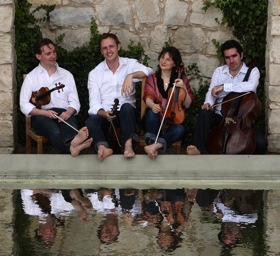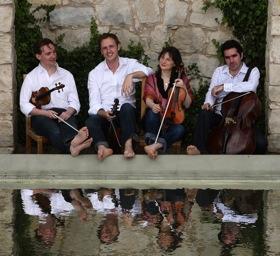Word of the Kuss Quartett preceded its actual appearance here. That’s pretty much how things do happen in the Bay Area with string quartets that haven’t actually been born here, but in the case of the Berlin-based Kuss Quartett it wasn’t “word” so much as whispers. You would think that a touring ensemble with a bunch of recordings to its credit and an international reputation would generate some buzz. But the audience at Thursday’s Herbst Theatre recital (sponsored by San Francisco Performances) was smallish, and the print media attention was nil.

That was a mistake. This is a quartet with a great deal to say. Thursday’s recital gave anyone listening a sense both of the ensemble’s limitations and of its strengths. I doubt that any fair listener would deny that the strengths won.
The quartet has a markedly uniform manner of playing, and an unusual one. They don’t use a lot of vibrato, but they do use a lot of bow, and often skirt the surface of the string. Everything is fast (bow-wise) and sparse (vibrato-wise), even when they play at full tilt.
How that sorts out depends on the music at issue. The concert opened with a rarely played, but magnificent, Haydn quartet, Op. 54/2. Haydn liked to confound expectations; still, there aren’t many pieces like this one, with its strange passacaglia -plus-Gypsyish-embellishments second movement and its slow finale (interrupted, true, by a fast section, but closed by the slow music again). Nothing in the piece quite goes according to stock design. The minuet follows on directly from the passacaglia, and has a trio section haunted by a shocking chord that just won’t go away.
The Kuss players know and understand Haydn, all right. I don’t think I’ve heard a live performance of this quartet so intelligent and so minutely attentive to the direction of the music. You heard it instantly in the first few bars: There’s a chord from the lower three players and a roulade of arpeggios from the first violin, who comes to a stop a shade after everyone else with a questioning final two notes. Jana Kuss here was perfect. Two tiny, pert up-bows, as though to say to everyone else, “Now what?”
A few seconds later, Haydn dumps the quartet and the audience into a key four flats distant — for a few bars only; then you’re back home, for the moment. It should be a shock, followed by sweet relief. And it was, here: The shock was a real shock, and the relaxation back into the home key, which can feel perfunctory, was blissful.
Throughout the Haydn the Kuss players were subtle, flexible, unpredictable. Jana Kuss’ account of the second movement’s top line was remarkable; if you didn’t know the score, you would assume that the music was improvised on the spot, so elastic and eloquent was her playing. As for the extraordinary finale: The program notes made no mention of the movement’s flabbergasting cello line, which ascends well into violin range. And cellist Mikayel Hakhnazarayan made no particular deal of it either; he just sailed slowly up, smoothly and with perfect equanimity.
Surfeit of Smoothness
Smoothness indeed proved a key Kuss trait, and there were times when I wished there were less of it. Beethoven’s Op. 135 quartet ended the concert, and if there be such a thing as irritating suavity, this performance verged on it. Granted, it’s the most genial of the late Beethoven quartets. But, there are things in there transparently meant to be jarring, like that weird unison E-flat early in the scherzo, and hearing them softened up is a shock of another kind. Kuss herself was dynamite in the trio section, where the first violin bounces on a sort of ostinato trampoline laid out by the other three players; still, I could’ve wished for stiffer springs.
The slow movement was luminous, and the fast parts of the finale well-nigh perfect. (Hakhnazarayan has a way of tossing off that second theme that other quartet cellists could profitably imitate.) I wish, though, I had been more convinced by the “Muss es sein?” bits. They were cold, minimally vibrated, not much dug-into (as indeed very little was).
I’ve heard players who don’t know “period” style, but think they have to emulate it, do very much the same thing. Sleek it out, stow the vibrato, don’t dig in. That actual “period” players don’t do any of these things (particularly the not-digging-in) doesn’t register if you’re trying to match a rumor rather than a style you’ve actually seen. It’s a manner that may pay dividends, depending on the repertoire. Not even the authenticists pretend that it’s actually authentic.
In Berg’s Op. 3 Quartet, though, no one could have denied the effectiveness of the Kuss manner. The piece is a slithery sort of thing, and quartets that play it (which is relatively few) either highlight the slitheriness by making the piece into the last gasp of hothouse Romanticism, or else butch it up by solidifying everything and pretending that it’s all “pure interval music” (as Stravinsky said of the Grosse Fuge).
The Kuss Quartett, bless ’em, didn’t treat the piece as an ideological football, but as music. So there was deft inflection, great care with balances, and no hysterical squealing to prove anyone’s late-late-Romantic credentials. The playing was almost indecently intelligent. Can Sony (which is recording this ensemble) be persuaded to set this down?
The encore was a pair of Armenian songs, arranged for string quartet by one S. Aslamazyan. These were brilliant and colorful pieces, with tasty parts for everyone in the ensemble, and ingeniously arranged.

